How To Get A Chainsaw Unstuck? Expert Tips for a Quick Solution
- February 2, 2024
- 5 comment
Getting your chainsaw stuck in a tree is a common mishap for anyone who uses a chainsaw, be it occasionally or frequently. While the situation may seem daunting, especially for first-timers, there are effective strategies and tools you can use to retrieve your chainsaw safely.
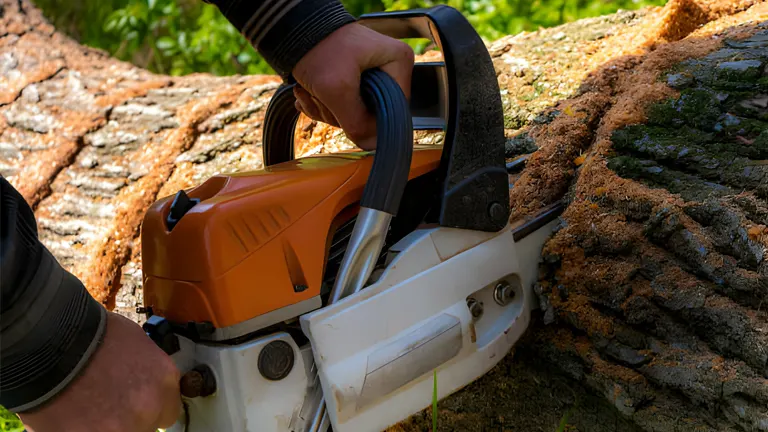
With experience, you’ll not only learn how to extricate your chainsaw with ease but also how to prevent it from getting stuck in the first place. Here’s a comprehensive guide on how to handle a stuck chainsaw, whether the tree is still standing or lying on the ground, along with some preventative measures to avoid future incidents.
When the Tree is Still Standing
Dealing with a chainsaw stuck mid-felling is a situation many lumberjacks and gardeners encounter. Especially in areas surrounded by structures or delicate landscaping, extracting your chainsaw demands a blend of precision and strength. Here’s how to approach the task with effectiveness and safety in mind:
1. Push the Tree
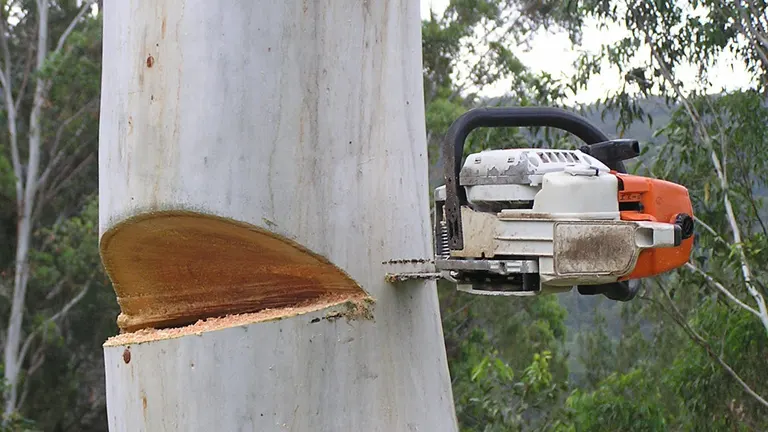
Sometimes, a simple solution is the most effective. If the tree isn’t too large, gently push it in the direction opposite to your cut. This can create enough slack to release your chainsaw. However, ensure you have enough manpower and that doing so won’t cause the tree to fall in an unsafe direction.
2. Use Wedges and a Hammer
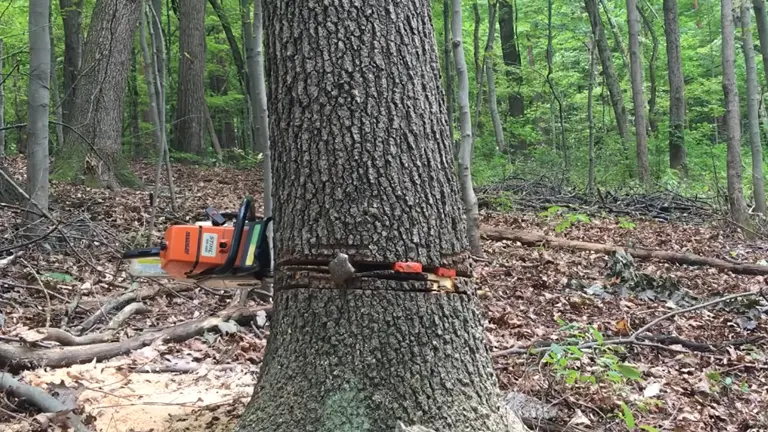
This traditional yet powerful method involves placing wedges into the cut and driving them further using a heavy hammer. The goal is to create a small opening or lift the tree just enough to wiggle your chainsaw free. It’s a method that combines finesse with brute force, offering a controlled way to free your tool.
3. Employ Another Chainsaw
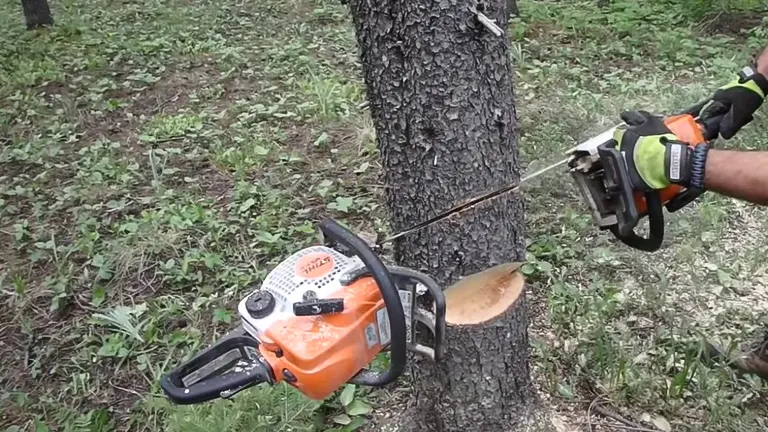
In some scenarios, using a second chainsaw might be your best bet. Make a careful and calculated cut on the opposite side of where the first chainsaw is stuck. This can cause the tree to lean away, reducing the pressure on the stuck chainsaw and allowing you to retrieve it. However, this method requires precision and should be handled by someone experienced in handling chainsaws.
4. Create Leverage with Rope and Ladder
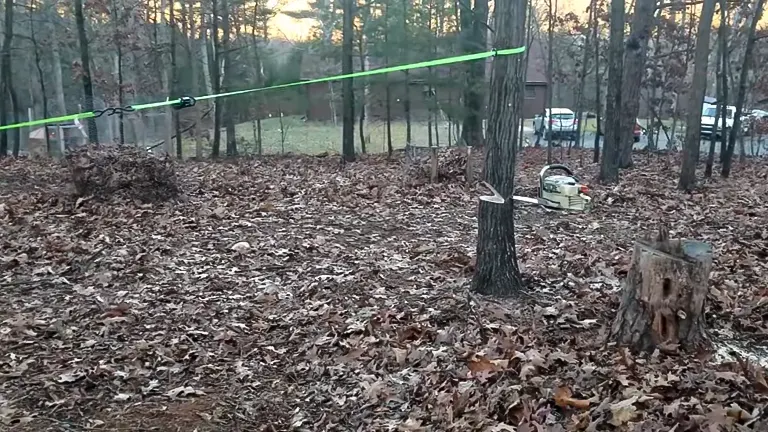
For trees that are stubbornly holding onto your chainsaw, creating leverage might be necessary. This method is more complex and involves tying a strong rope to a secure part of the tree, ideally higher up. Once secured, you can use manpower or even a vehicle to pull on the rope, thus tilting the tree and reducing the pinch on your chainsaw. It’s a method that requires careful planning and safety measures, as the force applied can be substantial.
When the Tree is On the Ground
When a tree is already on the ground, the dynamics of freeing a stuck chainsaw change for the better. You don’t have the added complexity of a potentially falling tree, but you still need smart techniques and a bit of muscle to get your chainsaw back in action. Here are effective strategies to consider:
1. Leverage with Logs or Tools
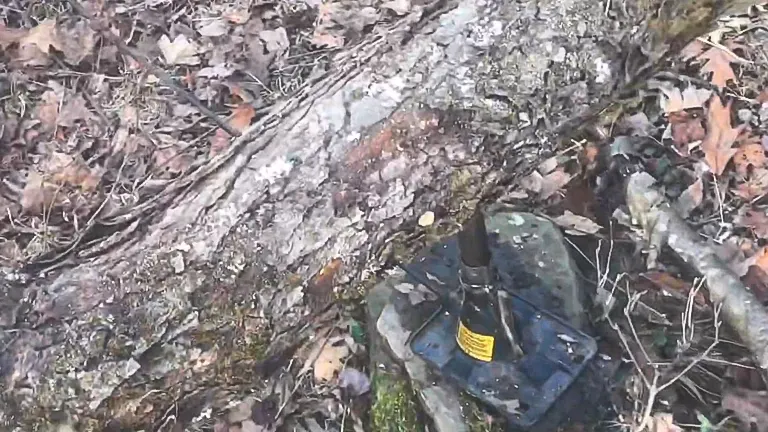
Nature often provides its own set of tools. Inspect the tree for natural levers or gaps that you can take advantage of. You might find bends in the trunk or spaces between the tree and the ground. Placing sturdy logs, wedges, or even crowbars under the tree section near the stuck chainsaw can provide the leverage needed to lift the tree just enough, freeing your chainsaw. This method is often about finding the right fulcrum point to apply your force.
2. Employ Tools Strategically
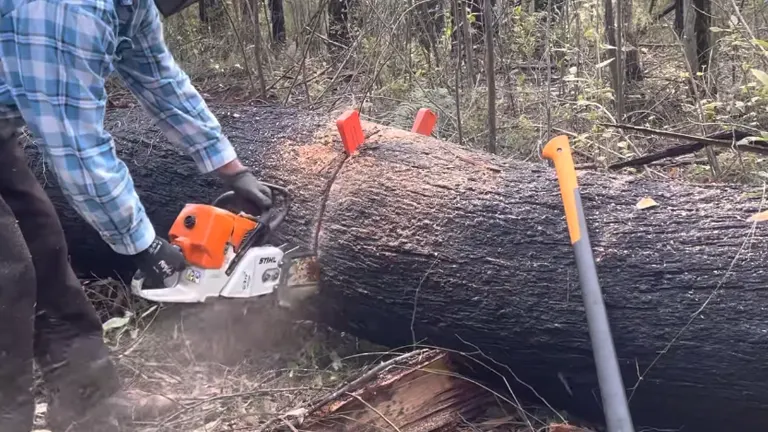
If the tree’s weight is squarely on your chainsaw, you’ll need more than brute strength to solve the problem. This is where tools like wedges and crowbars become invaluable. Insert the wedges into the cut, then use a hammer or another tool to drive them deeper, gradually prying the tree open. Similarly, a robust crowbar can provide the leverage needed to widen the gap just enough to slide your chainsaw out. Sometimes, combining these tools — using a wedge to create an initial gap, and then a crowbar to widen it can provide the best results.
Preventative Measures for Avoiding a Stuck Chainsaw
A stuck chainsaw can turn a routine cutting job into a frustrating ordeal. However, with some foresight and the right techniques, you can significantly reduce the likelihood of your chainsaw getting trapped. Here are some key preventative measures:
Use Wedges During Cutting
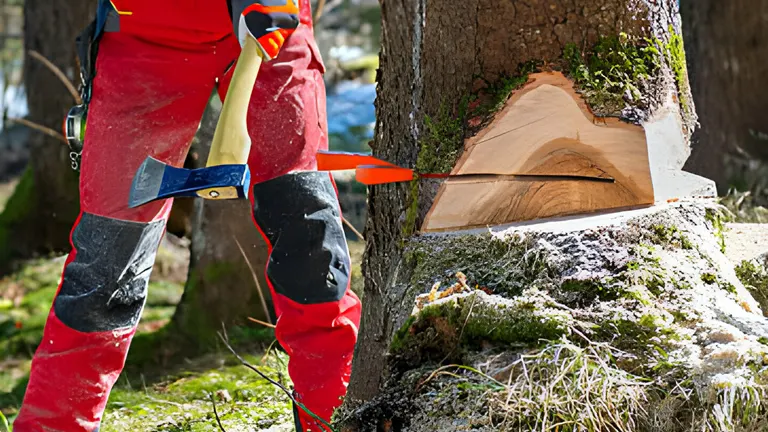
The simple act of inserting wedges into your cuts can make a world of difference. As you cut into a tree or log, the wood can start to close in on the chainsaw blade, causing it to become pinched. By placing wedges, you maintain an open cut, preventing the tree from collapsing on your chainsaw. This method is particularly effective in larger cuts where the weight of the tree can cause significant pinching.
Understand Compression and Tension Zones
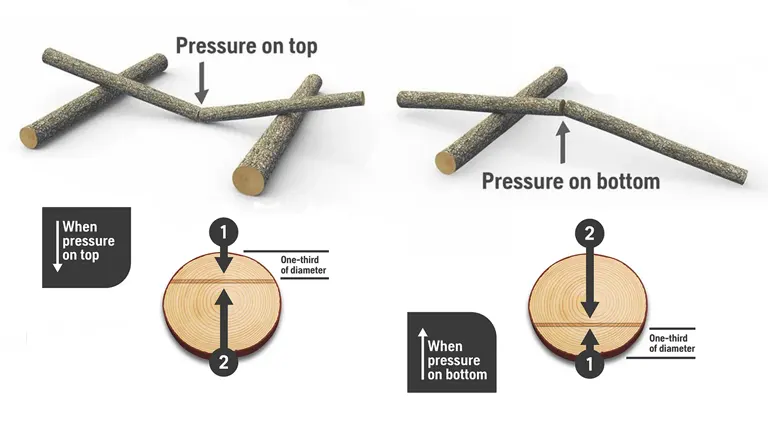
Wood behaves differently depending on how it’s supported and where the cuts are made. Identifying the compression (where the wood fibers are being pushed together) and tension zones (where the fibers are being pulled apart) in a log can guide you on where to start and finish your cuts. For instance, when a log is supported at both ends, the middle is often under compression. Starting your cut here and finishing in a tension zone can help prevent the chainsaw from getting stuck.
Support the Log Before Cutting

Proper support isn’t just about making the cutting process easier; it’s about preventing your chainsaw from becoming trapped. By elevating the log or ensuring it’s securely positioned, you reduce the chances of unpredictable movements during cutting, which can lead to pinching. Supports can be anything from commercially available log stands to improvised solutions like other logs or large stones.
Employ the Cross-Cutting Technique
Cross-cutting is a method where you make strategic cuts to manage the tension within the tree or log. This technique is especially useful when dealing with large trees or logs. The idea is to make a series of cuts that release the internal stresses gradually, preventing the wood from clamping down on your chainsaw. It requires a bit of practice to master but can be incredibly effective in ensuring smooth, uninterrupted cuts.
Prioritizing Safety in Chainsaw Retrieval
Handling a chainsaw, especially when it’s stuck, requires not just skill but also a deep commitment to safety for yourself and those around you. Adhering to these safety principles is not just about preventing damage to your chainsaw; it’s fundamentally about ensuring that everyone walks away without injuries. Here are the key safety measures to keep in mind:
- Wear Protective Gear: Before you even approach the stuck chainsaw, make sure you are properly equipped. A protective helmet with a face shield, sturdy gloves, and eye protection are non-negotiable. They protect you from flying debris, accidental slips of the tool, and other unforeseen incidents.
- Be Cautious of Your Surroundings: Analyze the area where you’re working. Are there any potential hazards, such as uneven ground, overhead lines, or nearby structures that could pose a risk? Ensure you have a clear understanding of the terrain and maintain a safe position relative to the log and the chainsaw. Always have a clear path to retreat if the situation calls for it.
- Avoid Direct Force: It might be tempting to yank the chainsaw out, but applying direct force without first relieving the pressure can lead to damage or, worse, injury. Such actions can cause the chainsaw to kick back or the wood to split unpredictably. Always seek to gradually release the pressure using the methods described earlier.
By rigorously following these safety measures, you not only protect yourself and others but also ensure that your chainsaw remains in good working order for future tasks. Remember, when it comes to handling powerful tools like chainsaws, safety is not just a precaution; it’s the foundation of effective and responsible operation.
Related Articles:
- Why My Chainsaw Won’t Start
- Correct Way To Tune The Carburetor On A Chainsaw
- How to Store a Chainsaw So It Doesn’t Leak Oil
- Why Do Chainsaws Leak Bar Oil? Understanding the Causes and Solutions
- Do Electric Chainsaws Need Oil? Everything You Need to Know
- Can You Cut Bamboo With A Chainsaw?
FAQs
- What’s the safest way to approach a chainsaw that’s stuck in a tree or log?
Before attempting any retrieval method, ensure the chainsaw is turned off. Assess the situation from a safe distance, considering the tree’s position and potential movement. Always wear appropriate safety gear and ensure you have a clear escape path. - Can the weather affect how I should free my chainsaw?
Yes, weather conditions like rain or snow can make the wood slippery, affecting your grip and the overall safety. Wet conditions can also affect the tools you use, like wedges, which might not hold as well in soggy wood. - Is there a risk of damaging my chainsaw while trying to free it?
There’s always a risk, especially if force is applied incorrectly. To minimize damage, avoid pulling the chainsaw out with excessive force and use tools like wedges and crowbars gently to avoid bending the saw’s bar or damaging the chain. - How can I prevent my chainsaw from getting stuck in the future?
Regular maintenance of your chainsaw, proper cutting techniques, and the use of tools like wedges can significantly reduce the chances of your chainsaw getting stuck. Also, understanding the type of wood and its characteristics (like hardness and fiber structure) can guide your cutting approach. - What should I do if my chainsaw is electric and gets stuck?
For electric chainsaws, ensure the battery is removed or the power cord is unplugged before attempting to free the saw. This prevents the accidental starting of the chainsaw during retrieval. - Can a stuck chainsaw cause long-term damage to the tree?
If the chainsaw is stuck for an extended period, or if the methods used to free it are invasive, there can be damage to the tree, especially if it’s still living. It’s important to balance the health of the tree with the retrieval of your chainsaw. - How often should I sharpen my chainsaw to prevent it from getting stuck?
The frequency can vary based on usage, but generally, it’s good practice to sharpen the chain after every significant cutting session. A sharp chain cuts more efficiently and is less likely to get stuck. - Are there specific techniques for freeing a chainsaw in dense woods or confined spaces?
In dense woods, it’s crucial to keep a clear area around the working space. Use compact tools like hand wedges or small crowbars. If space allows, a small hand winch can be quite effective and doesn’t require a lot of room. - What’s the role of a chainsaw’s anti-kickback features when it gets stuck?
Anti-kickback features are designed to reduce the risk of the chainsaw lurching back towards the user if it gets stuck or pinched. While they don’t prevent the chainsaw from getting stuck, they do provide an additional layer of safety during the cutting process. - Can I use oil or lubricants to make it easier to remove a stuck chainsaw?
While lubricants can help in some scenarios, they should be used with caution. Oils can attract dirt and debris, potentially clogging the chain or creating a slippery and unsafe working environment. If you choose to use a lubricant, apply it sparingly and clean the chainsaw thoroughly after retrieval.
Join the discussion below by sharing your experiences, tips, or reviews. Your contributions help others make informed decisions and navigate their chainsaw choices with confidence. Let’s build a community of shared knowledge for all wood-cutting enthusiasts!

David Murray
Forestry AuthorI'm David Murry, a forestry equipment specialist with a focus on chainsaw operation. With over 13 years of experience, I've honed my skills in operating and maintaining a wide range of machinery, from chainsaws to log splitters. My passion for the outdoors and commitment to sustainable forestry drive my work, which emphasizes safety, efficiency, and staying updated with industry advancements. Additionally, I'm dedicated to sharing my expertise and promoting environmental awareness within the forestry community.
5 comments
I carefully use a cant hook / peavy, and or log jack or a pickaroon usually works for unsticking in smaller stuff. I use a peavy to twist a felled tree that has set back down on its stump due to intertwined vines or limbs attached to adjoining trees or whatever has it bound up. But, Just be careful alert and watch tree while you are spinning it with the peavy to release it from the stump you should "ALWAYS"have a escape route plan prior too doing any felling or cutting of anything that is over head with no exceptions! All you really need is some common sence and being 10% smarter than what you are trying to accomplish is always helpful
Joe
February 7, 2024 3:17 amGlad to read these informations, Thanks David!
Griffin Stello
February 5, 2024 7:15 amIt is great to know these things so valuable
tamapua maurangi
February 4, 2024 7:01 pmJust master cross cutting, Btw great article and keep safe!

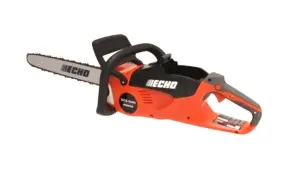
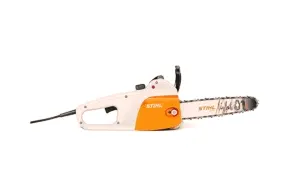
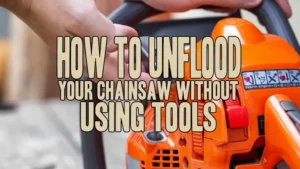
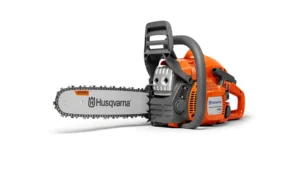
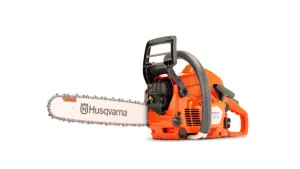

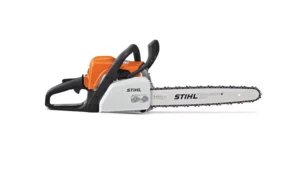
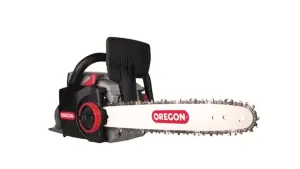

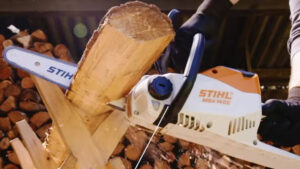
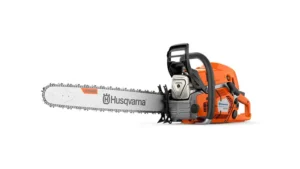
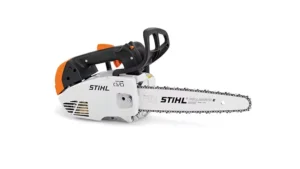
I keep a spare bar and chain with me. If the chainsaw gets stuck I can remove the power head from the stuck bar/chain to prevent more damage to my equipment while getting things unstuck. If I need to make more cuts to free the first bar/chain I can just put the spare bar and chain on the power head rather than needing a second chainsaw.
Katrina Speer
February 22, 2024 4:25 pm